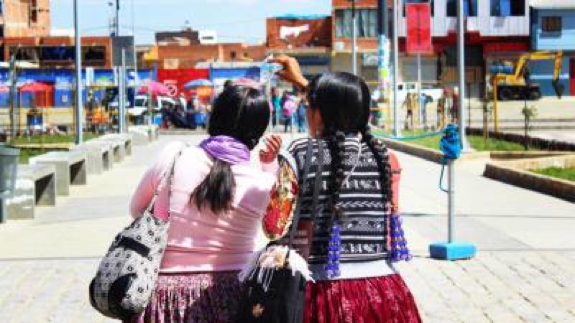
Bolivia and the new Andean Right
September 22, 2015 - opendemocracy.net
As with Macri in Argentina, Capriles in Venezuela or Rodas in Ecuador, the Bolivian right is growing stronger. A young Aymara woman is now the hope to defeat Evo Morales.
Pablo Stefanoni
[Read about the author at end of this article]
The cable car is pulling hard, and at an angle of 45 degrees makes the last leg of the journey between 'la Hoyada', the popular name for La Paz, and El Alto, the rebel Aymara city that during three decades has constructed an identity by means of colorful buildings and a heavy population and commercial density. From four thousand meters above sea level the one million strong population of El Alto brought down two presidents in the early years of the new century and voted massively voted for Evo Morales in three elections, but recently surprised by choosing as mayor Soledad Chapetón, a young woman and leader of a new Andean right that dreams of coming to power through the ballot box.
On March 29, 2015, defying the President's call to vote for the MAS (Movimiento Hacia el Socialismo) aspirant, El Alto voted in Chapetón, candidate of the National Unity (Unidad Nacional - UN) party led by Samuel Doria Medina, one of the richest men in the country and second in October 2014 presidential elections. Her victory put a dent in the local structures attached to the ruling national party, and she hopes to become the popular face of a party associated with the name of a millionaire businessman. Her first weeks in office, on the other hand, were not exactly quiet.
The iconic city of the 2003 'Gas War' that ousted President Gonzalo Sanchez de Lozada – and would soon do the same to Carlos Mesa – may surprise those who go looking for authenticity: here there is an ice cream parlour called 'Bits & Cream', while another has creams of various colors to add to ice cream, snow cones. The small stand, 'Steel City', offers jewelry and other products made of steel. The Qhana Pata (Mirador) cable car station in the neighborhood of 'Satellite City' is now one of the main entrances to this municipality that has ceased to be satellite of La Paz.
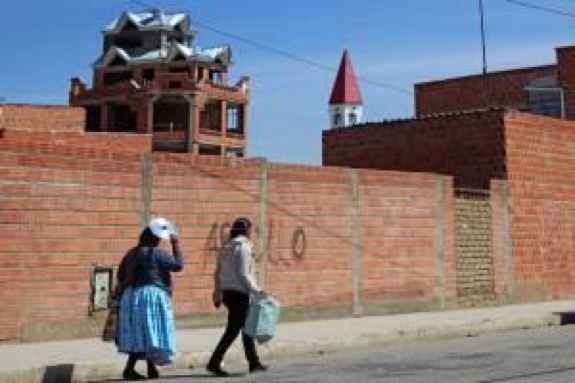
In the altitude, the combination of freezing wind and scorching sun provokes a strange combination of cold, heat and fatigue, but surely no one recently felt anything like Count Hermann Keyserling, German philosopher invited to Buenos Aires by Victoria Ocampo in 1929, who continued into the highlands of La Paz where, as he recalled in his South American Memoirs: was seized with a feeling similar to that of the "reptiles confronted by telluric influences that posed the dilemma of becoming mammals or perishing". It was then that he became aware, as he put it, of his own "minerality".
'La Sole' as almost everyone knows her – her secretary calls her "the lawyer" – enters the office after almost running up three flights of stairs, carrying a wallet, some papers and a bag of coca leaves. And it is hot: like many houses in the city, the roof of the party offices consists of corrugated plastic sheets designed to create a greenhouse effect: transforming the sunlight into heat.
-¿Do you chew (Pijchea) coca leaf?
– Yes, I did a lot in college, now I share it with my mom, and even my dog 'pijchea'.
In the late March elections the population of El Alto (the Alteños) decided to turn their back on the Movement Towards Socialism (MAS) and the current mayor, Edgar Patana, an ex-leader of an association of street vendors, and elect Chapetón, 34, single, and militant of a party considered by the government to be the right in sheep's clothing. She may have beaten the MAS candidate with 55% of the vote, but her answers are cautious.
-¿Did you beat Patana or Evo Morales?
I don't know, I'm not a political analyst. I'm in politics to do something for my city, for me that's politics. But it is true that when we saw that the President was involved in the campaign then it wasn't simply about Patana. But the truth is that in El Alto earned itself another chance.
With intensely black hair, 'La Sole' considers herself to be "a forward looking Aymara woman", and unlike other mayors who governed the city, was born and raised in this place marked by the traumatic images of 2003: dozens of dead and wounded, blocked roads, neighborhood councils on the warpath against Sanchez de Lozada's decision to export gas to the United States by way of Chilean ports. Chapetón – with a degree in Education from the Universidad Mayor de San Andres in La Paz – does not speak but understands the language of her parents and grandparents, and also considers herself marked by the 'Gas War'; indeed, the pride of the Alteños is irrevocably linked to the events of those days:
-In 2003 she was studying and working. "Each zone of the city had its schedule for participating in the actions and road closings, and everyone participated. We felt the weight of police and military repression and the callousness of the authorities: the assassinations, disappearances … I was in Bolivia Street blocking the road, preventing the fuel trucks from getting down into La Paz."
The removal of the barricades at gun point ordered by the "Fox" Carlos Sanchez Berzain, the strongman of the time, in an attempt to provide gasoline and liquid gas to La Paz, produced casualties and helped to radicalize the protest movement. On October 17 Sanchez de Lozada (Goni) fled, first to the city of Santa Cruz in the East of the country and then to the United States. A return to La Paz means being put on trial, but Washington is unlikely to give him up, and it is speculated that in addition to having a "gringo" accent, he has US citizenship.
As an 'Alteña', 2003 had an effect on me says Chapetón, who was 23 at the time.
Today one of her main adversaries is Braulio Rocha, executive secretary of the Federation of Guilds of El Alto, a union leader with little social prestige, who has promised to become "Soledad Chapetón's nightmare". He and his allies tried to promote a civic strike because they felt excluded from the appointment of deputy mayors, but the move failed and 'La Sole' came out of it strengthened.
I'm "fully prepared" to face him, but he must understand that the campaign has ended, she says from behind her desk in a small office, while a group of people in the room wait to talk to her. They could be people that are now starting to ask the new mayor for things – above all "projects" for their areas. Governing the youngest city in Bolivia (both the city and its inhabitants are young) is not easy. And in El Alto there seems to be a lack of everything.
Chapetón repeatedly uses the term 'plurinational state', the new official name for Bolivia that is rejected by the hard right, while speaking of coca as 'the sacred leaf', while saying she is open to reforms such as civil unions between people of the same sex: "The world and societies have undergone major changes and this needs to be addressed with public policies, rights, and respect." She says she does not identify with any foreign politician and recognizes the contributions of US cooperation in El Alto via USAID. But she is most forceful when she denies that her party and herself are on the right of the political spectrum: "I was came into political life in a center-left party: National Unity (UN). The statutes say it is a left wing social democratic party. I have never been, nor am right wing."
In the room UN militants call each other "compañero", and a large sign carries the photo of the party leader, striving to smile, with the caption: Samuel for president. Its color is yellow.
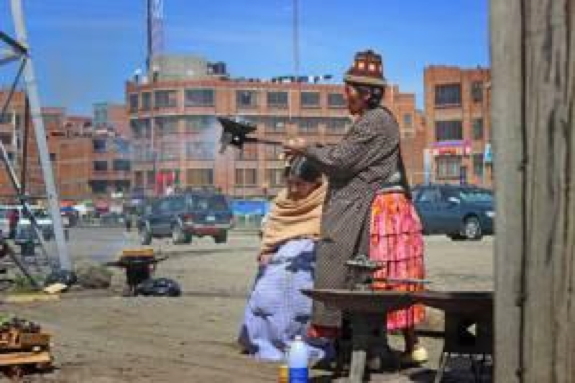
Samuel is a survivor. When at 9.55 am on January 21, 2005 the corporate jet in which he was traveling to the Bolivian Amazon spun out of control and crashed to the ground, the businessman thought, "Shit, I can't die". Or so he said during the last presidential campaign; the expression was ridiculed and led to countless memes and some satirical rap, but also contributed to his coming in second place with 25% of the vote (Evo Morales polled more than 60%) in his third attempt to reach the Palacio Quemado (Presidential Palace; literally: the Burnt-down Palace). For this last campaign he allied himself with the governor of Santa Cruz Province, the autonomist Ruben Costas.
Samuel, as he is popularly known – is an economist with postgraduate degree gained in England who was a World Bank official, a Government Minister in the nineties and, until he recently sold his cement company SOBOCE, a leading Bolivian industrialist. He also owns the country's Burger King franchise. His style is dry and drab, but his life is permeated by wealth and adversity that have provided him with a "mission", though perhaps in his own mind, to be president. Ten years before his crash he was kidnapped by the Tupac Amaru Revolutionary Movement, the Peruvian guerrilla group in November 1995, and spent 45 days in captivity. Samuel could easily live on a beach (the place where in the popular imagination all the rich and famous go) but he prefers the quicksand of Bolivian politics.
During the Constituent Assembly of 2006, anyone who did not know him would hardly have imagined that one of the assemblymen lying on a mat, on a hunger strike to protest against the ruling party, was a millionaire passionate about politics.
-¿Samuel Doria Medina is Bolivia's richest man? I asked in an interview for Argentinian newspaper Página12 in 2005.
"I am proud to invest in my country, to have been successful and shown that Bolivia can be competitive (…) I'm not ashamed to say that I've done well and that my companies are efficient. Everything I made has been reinvested in the country; I did not send it to Miami" –he said forcefully. At the time of the interview, in his fight against Evo Morales and the right wing Jorge "Tuto" Quiroga, he took a equidistant position, "betting on a "FTAA lite, like Lula"
Samuel refused to join with the right and struggled for a "popular center" position. He even brought up his affiliation to the social democratic Revolutionary Left Movement (MIR). His affiliation led him to become a minister in the government of Jaime Paz Zamora (1989-93), an ex-seminarian who was also involved in a plane crash and survived. That was 1982 before Zamora became vice president in a left wing government, and he also has the marks on him to show that he is a survivor, although today he is no longer in politics, unlike the 56 year old ex-cement impresario.
Evo Morales continues to point out that Doria Medina's time in the Ministry of Planning makes him as a privatizer: the worst kind of insult in this Bolivian "golden" decade.
In the recent local elections the Bolivian president did not hesitate to say that Doria Medina was trying to rearticulate the right from the El Alto municipality together with 'La Sole'. "Doria Medina is still conspiring against the administration of President Evo Morales and that is why he wants to turn the municipality of El Alto into his beachhead and destabilize the process of change", declared the President, speaking of himself in the third person, trying hard to avoid an announced electoral defeat in El Alto. A leaked video showed the previous mayor Edgar Patana – the MAS candidate for reelection – receiving an 'envelope' years ago when he was a union leader. It was the final blow to his candidacy, whose unpopularity hung heavy in the air, in a city with ruralized aesthetics: "he doesn't build anything", "He's corrupt," "I'm going to vote for change", "I don't want to vote for Patana". Patana protested that there was no money in the package, but could not remember its contents.
The same El Alto that voted massively for Evo in October 2014 – and his candidates for deputies in El Alto – was preparing to not comply with his request that, despite everything, they mark the ballot paper to support the MAS process of change. A MAS deputy for El Alto got off a van when she saw her own supporters of a few months previously now painting signs for 'La Sole' … She was not able to change their mind.
The concept of a "new right" is being used to describe the opposition in countries with post-neoliberal governments. This new right has been trying to eradicate the stigma of being seen as wanting to restore the old neoliberal order by rescuing social policy, not despising the state as right wing candidates did in the nineteen nineties, and playing the democratic game. Henrique Capriles in Venezuela, Mauricio Macri in Argentina and Mauricio Rodas in Ecuador seem to fit in this category, with the caveat that this is not the first time there has been talk of a 'new right'.
In the last elections, Evo Morales tried to take Patana out of the picture, because he saw it all coming, but David Choquehuanca Foreign Minister and campaign manager in La Paz, failed due to the links the mayor had made with leaders of the main El Alto social organizations: the Federation of Neighborhood Committees (Fejuve), the Regional and Central Workers Union Federation. The leadership of these organizations also lost the voted on March 29.
And MAS not only lost El Alto. Apart from the city of La Paz (already in the hands of the opposition center-left mayor Luis "Lucho" Revilla), its biggest defeat came in the race for Provincial governor. The indigenous-campesino candidate Felipa Huanca, leader of the Bartolinas (the popular name for the members of the 'National Association of Campesino Indigenous Women-Bartolina Sisa'), was also accused of corruption and could not, or did not want to deny it with the finality the situation required, thus weakening the aura of "moral reserve" that she as a woman and indigenous person, should have been able use to compensate for her lack of experience in governing. She was defeated by Professor Felix Patzi Paco, Aymara and minister in Evo Morales' first government and today part of the opposition (the government describes these ex-government people as resentful).
Although Morales won in many other regions and municipalities (the majority in fact), he experienced the bitter taste of losing where he could not, in the bastion of the new century's social struggles. To this were added the losses sustained in the majority of provincial capitals, i.e. the most populated areas. On other hand, while Bolivians may not believe in political loyalties, at the moment Evo is still unbeatable.
(below) Soledad Chapetón, elected mayor of El Alto.
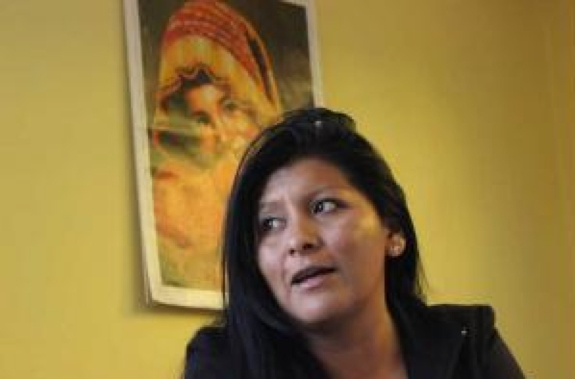
Carlos Laruta also emphatically denies belonging to a right-wing party. Despite having an impressive curriculum which includes a long stay abroad, this sociologist from El Alto decided not to leave the city to which his father migrated. Laruta's father "came to El Alto with sandals and became urbanized."The former candidate for governor and leading member of the UN says his grandfather was an Aymara peasant who fled from the hacienda and ended up working for Bolivia Railways, on the Arica-La Paz railway line Bolivia got in exchange for the loss of coastline to the Chileans in the War of the Pacific. The loss is a hot topic today due to the Bolivian court case brought to the International Court of the Hague against the country's neighbor on the other side of the Andes.
To talk about politics and El Alto, this professor of sociology at the University of San Andrés in La Paz invited me to lunch at the restaurant El Rancho, on the road to Viacha. Here you can find part of the El Alto "middle class": mestizo men and 'pollera' ladies, the politically correct name for the 'Cholas'( loosely defined term that refers to individuals of mixed or pure Native-American ancestry, or other racially mixed origin; in modern American usage, it most often applies to the low-rider sub-culture manner of dress). The dishes are not cheap: a plate of lamb with a bicervecina (fermented barley with 3.5% alcohol) costs ten dollars and the families are not a few. This is evidence of Bolivia's economic boom, today praised by the World Bank or the New York Times, that for the moment has not only been immune to low raw material prices, but has a financial reserve equivalent to half the country's GDP (GDP per capita is almost triple that of 2005, and the Andean nation has become a middle income country). Minister of economy Luis Arce has broken all the records: he has been the minister since the beginning of Evo's tenure, a total of nine years on the job. He declares that it is possible to have "socialist policies with macroeconomic balance".
While separating the lamb chuño (a black potato dried in ice which is very popular in the Altiplano), Laruta recalls his time in the Socialist Party at University, his activity as part of the leadership of the Center for Research and Promotion of Small Farmers (CIPCA), a progressive NGO, and his work in Guatemala in the 90s – as part of a special United nations mission in the post-conflict reconstruction in the country. He goes on:
"The Unidad Nacional is a social democratic party. Samuel is not a right winger, he's a rich businessman; you can exclude the rich on principle but …." He often confronted extreme liberals and believes that a large sector of the economy should be managed by the state, but in a transparent way.
Needless to say he believes the current government does not do that. Moreover, he emphasizes that as owner of the SOBOCE cement company, Samuel could have asked for a limestone mining concession, but preferred an "alliance" with local small farmers, thus showing "not only social responsibility, but commitment." A commitment that is the expression of a "plural economy" that recognizes and promotes the constitution adopted in 2009. And, he ends: "the UN is not a traditional party, it is also a product of 2003, in fact the 'Gas War' was in October and the UN was born in December of that year."
'La Sole' reflects the same position: "I look at the people in all their dimensions. Although Samuel is a successful entrepreneur, he is also a very human person; I myself have checked his companies' social commitment. We must not discriminate by skin color or by social position. We judge people for what they are. Samuel feels that politics is a service."
However, Jaime Navarro, a 'samuelismo' leader, or the Cochabamba Senator Arturo Murillo hardly qualify as left wing, no matter the "stickers" they might be given. Nor does Adrian Oliva, governor of Tarija, a recent UN ally and one of the founders of the Democratic Parliamentary Alliance of America, group that considering the regions' national-popular governments to be 'totalitarian'.
In a recent article in New Society (Nueva Sociedad) magazine, Fernando Molina, a leading Bolivian political analysts, located in the UN as the "moderate" right wing opposition: "In the 'national vision' of UN the central theme might be: 'National reconciliation, continuity and innovation in order to build a country for all and, as a summary of the party's political objective: a synthesis that brings together the best of what we've done so far, to continue with it and not repeat past mistakes, and to do what has not been done until now".
'Synthesis' means, of course, dialogue between two different political proposals, in this case the liberalism of the opposition and the popular nationalism of Morales' MAS".
Laruta argues that "Evo screwed everyone in El Alto with the non-renewal of the ATPDEA" (Andean Trade Promotion and Drug Eradication Act), 'a free trade agreement with the United States in exchange for the eradication of coca', which put an end to many local industries ". For the ruling party, the rejection of the FTA is the line that separates the neoliberal supporters of parties seeking a change, from those of decolonization or the Democratic and Cultural Revolution.
***
"The modernisation taking place in El Alto is syncretic, like the Japanese" states Laruta. Sociologist and politician, he likes to talk about entrepreneurs and, indeed, his party turned entrepreneurship into a kind of ideology at a time when it was more common to proclaim its end. He speaks enthusiastically of the most Aymara of Bolivian cities, and his gestures become even more emphatic when he remarks that his party, the UN, even managed to take shape in the combative environment of the Public University of El Alto (UPEA), where the left and the indianistas are the major force between dishes of chili noodle and rice with egg that are sold for a few cents outside the main gate.
– Many of the kids of these 'cholo entrepreneurs' from El Alto study at UPEA, and are pretty open to the UN's productivist line. These young people love the idea of entrepreneurship and business, enthuses Laruta. Doria Medina opened several Technological Innovation Centers (CITE) in El Alto, and included the proposal in his plan for government.
On a tour of El Alto's dusty streets – a city which lacks sewage and a great deal of urban infrastructure – buildings of an indefinable architecture catch the eye: they are called 'Cholets' (a combination of the words Cholo and Chalet) that can cost up to half a million dollars depending on the number of floors. Built with coloured glass and decorated with intense and even garish colors, these buildings are integral to the effort of the El Alto commercial bourgeoisie to assert and consolidate their commercial success; the buildings stand out amongst the generally unfinished monotonous orange brick constructions that dominate a city where piles of cement and sand are everywhere and only has traffic lights on the major arteries. In the neighborhoods, large dolls can sometimes be seen hung on lampposts with a sign warning that "thieves will be lynched and cars with no owner burned". Police are scarce; patrol cars even more so. Countless dogs, alone or in packs, rummage through trash and trees are lacking in the dry and dust. The name El Alto is associated with La Paz's airport, but also with its huge '16 de Julio' market, open Thursdays and Sundays, where they say, with evidence to prove it – you can find everything from baby pigs to the wings of old aircraft.
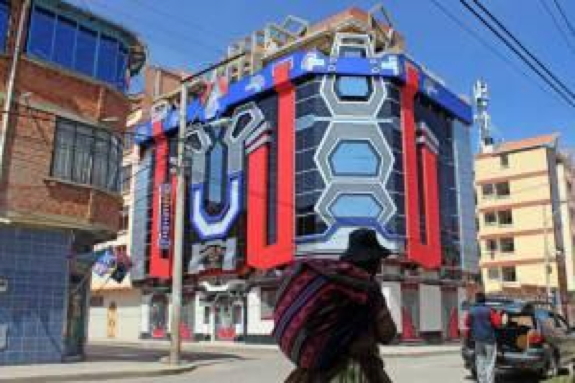
These "neo-Andean" palaces – with their geometric styles and Aymara crosses (Chacanas) that are reinventing tradition with no hangups – have been built above all on main streets such as 'Litoral' and 'Bolivia'. Each has its own style: the hallmark of whoever commissioned it. And one of those responsible for satisfying his customers' desire for prestige is Freddy Mamani. A member of a family of bricklayers who studied engineering he stands out among the architects of a style that came to the fore in the last decade, and that has no parallels in any other Andean country.
Although they are often spoken of as palaces, for the Aymara nouveau riche, they are "sustainable houses" consisting of several floors with different uses: on the ground floor usually there are business while on the next levels are offices or meeting rooms (almost inevitable and which give uniqueness to Cholets) and on the top floor the Cholet itself, inhabited by the owner. The style of Aymara festivities – collective – means that guests are many and private homes too small, thus the proliferation of these 'salons' that display not only the success of the owners, but also that of the people who organize their parties there (weddings, baptisms or fifteenth birthday), parties that are sometimes enlivened by bands hired from abroad. So community traditions blend with a powerful Andean capitalism, that as Vice President Alvaro Garcia Linera once put it, is characterized by never putting all your eggs in one basket. But if for the sociologist Vice President this capitalism can ultimately only be an obstacle for greater social change, for Laruta it is the base of the productivist model the country needs. A benefit provided by the weak national bourgeoisie of which 'Samuel' is a successful but little accompanied exponent.
Activities legal, in a context of sustained economic growth since 2006 (expansion of trade and imports together with remittances from abroad) or illegal (smuggling, and even drug trafficking), explain to a greater or lesser degree this boom of multicolored Cholets, whose interior decoration, finished with national or imported materials show the taste and purchasing power of the owners. Some call it, and not without contempt, "transformer architecture." Indeed, many Cholets have in fact have been inspired by the series of the same name, and have the hero Optimus Prime as a motif. They are even a tourist attraction: a group of girls from La Paz get out of a car and take pictures in 'Sentinel Prime', while some little girls playing ball make their escape from the flashes. But its creators believe that this is another type of architecture that cannot be confused with Andean. At least that's what Santos Churata, the factotum of the style thinks:
- Good afternoon, Mt. Churata I wanted to ask you about the El Alto Andean architecture …
- I don't do Andean architecture – I hate the idea – I build transformer, futuristic architecture, that no longer uses the Andean cross or strong colors …
- Why this type of architecture?
-Because of the movie, because of the robotic style. Most customers like something new, out of the ordinary, that will make a difference. The Andean architecture is too heavy, too loaded with colors, and we try to offer customers something different.
- How much is building like that worth?
-About US$400,000.
Freddy Mamani does design "Andean architecture", at least as it is known. "I made a visit to Tiwanaku and came away thinking that we should build things that show our ancient culture, works with Andean structures, with colors aguayos (a piece of multi-purpose, multi and brightly coloured cloth used in Bolivia, Peru and Argentina). I suggested that to the owner of a lot and he accepted; we put up the first building and painted it green because in El Alto there are no trees and we wanted to put a little color into the city. After that the whole thing just mushroomed," said Mamani in an interview with Nathalie Iriarte Villavicencio. One of his greatest works is the Prince Alexander ballroom, built for the entrepreneur and onetime assistant tailor Alejandro 'Chino' Quispe, who told Radio Erbol that the total cost came to about two million dollars and that "it really is a palace ". No one doubted it.
Although the phenomenon is often associated with Evo Morales, MAS is a peasant party that the urban cholos only joined later. Their real party was 'Conscience of the Fatherland', in the 90s, which was led by the legendary compadre (term of affection which can range in meaning from the formal 'godfather' to the informal 'friend' 'mate' or 'good guy') Carlos Palenque – renowned charanguista (the charango is a small guitar-like stringed musical instrument popular in the Andes, above all in indigenous communities) and now media entrepreneur – and the young comadre Monica Medina, who led the first pollera woman into Congress: Remedios Loza. El Alto was faithful to Palenque until his sudden death in 1997, and today the city remains faithful to Evo, but now that loyalty is shared with 'La Sole' in the hope that urban life can be improved. The leaders of the social organizations bargained for power and lost prestige.
The most emblematic Chola festival is that of Nuestro Señor de Gran Poder (Our Lord of Great Power) in La Paz. Some dancers hire private security to protect their jewelry, owned or rented. The excursions of the popular merchants of Bolivia, coordinated by Nico Tassi, speaks of the inclusion of these Aymara traders in the global economy, and whose networks take them to China. It is not difficult to find promotions for travel to the Asian nation in the windows of travel agencies in La Paz, especially to big fairs such as in Guangzhou. Amid the discussion of education reform, a group of merchants suggested that Mandarin Chinese be included in school curriculums. The Banks, meanwhile, have finally understood this Andean capitalism and opened branches in major El Alto areas, some of which cost as much per square meter as the exclusive South side of La Paz.
***
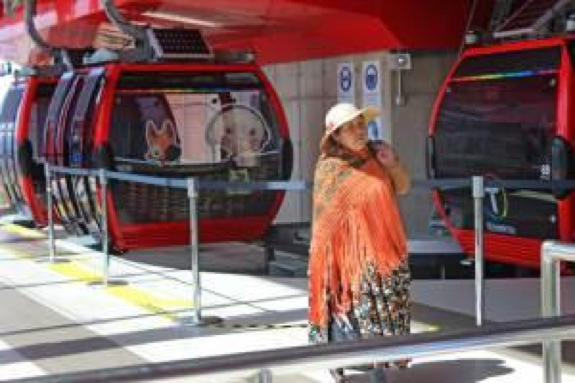
The cable car, inaugurated in mid 2014, is one of the stars of Evo Morales infrastructure programme. Its three lines (red, green and yellow, the colors of the national flag) joining El Alto to the formerly white area of South La Paz, whose changes and fears are well portrayed in the Juan Carlos Valdivia film 'Zona Sur'. Several more lines are now in the planning stages. Their social impact on a territory divided into three areas – El Alto, La Paz and the Southern Zone – will be a subject for urban sociologists and anthropologists in the future …
Although this means of transport hopes to alleviate road congestion, "My cable car" as it was dubbed, was quickly transformed into a Sunday stroll, and entire families -from grandparents to grandchildren, and many pollera ladies – can be seen sailing through the air down to La Paz while trying to identify known points down on the ground. Taking the yellow line and then the green, it is possible to travel the seven and a half kilometers separating El Alto from Irpavi, where the altitude is lower and the climate more pleasant. But for some this renewed link is an invasion and even a local version of "the clash of civilizations".
Photographs of people from El Alto sitting on the floor of the Megacenter (La Paz's largest shopping center) generated some extreme expressions of racism on social networks, as well as discussions between those who wanted to preserve 'their' free spaces and the 'intruders' who justified themselves by alluding to their ties with Mother Earth. "If they want to put an end the problem they should stop the cable car coming down from El Alto; kill the dog and the flea at the same time", "I can't imagine how the South side will end up with all the other cable cars to come … we have to do something, NOW!!!!". "The issue of the Megacentre and the cable car effect is bringing out the worst of everyone and makes it clear that 'inclusion' has so far only increased a silent, dangerous and unspoken racial hatred (…) (sic)" … Adopting a more pragmatic tone, Juan Patino, the Megacenter manager, said he was pleased "to expand markets"
– "Some of my relatives have changed their last name, Laruta in Aymara comes from the verb to laugh, 'laruña', but young people today know they are called or Mamani or Quispe and feel they are the same as everyone else. The concept of citizenship has finally caught on," says the sociologist.
Part of the current pride of the Alteños has to do with the barricades built in 2003, when thousands of them moved down into La Paz chanting "El Alto standing, never kneeling " or "Now it's civil war", with miners dynamite in hand, and today consider themselves the architects of the nationalization of natural gas fields which increased government revenues and enabled social and infrastructure policies. But many feel that the payback for their struggles has been limited.
For Laruta "Evo is part of the era of rebellion against the poverty of neoliberalism, but that time is over and now people are going to place more value on common sense". Furthermore, he believes that the success of the Unidad Nacional in El Alto will help give a popular face to a party associated with one of the richest men in Bolivia, whose background is remote from the dense working class population that typifies the country and its social life. Evo Morales is clearly more like most Bolivians than Samuel, although the UN has now 'La Sole' "just up there" close to the cable car and a little further from the combi buses and the traffic jams.
In a city where 75% are self-employed – "you don't get anything from the state" – the recently elected mayor says her dream is that in five years El Alto "will be a modern city on the road to development."
¿ Soledad Chapetón is a presidential candidate?
– My goal is to work for the city of El Alto. We have to recover the concept of politics at City Hall. In the long term only God knows …
In the 50s, while the mines were nationalized, the nationalist Fernando Diez de Medina called on people to shout out to the world with pride: "I am a Bolivian cholo". Six decades later, amidst a Bolivian scale economic boom, the cholets seem to be shouting that same message while at the same time creating a social division in the "rebel Aymara city" between those who are winners and the rest, and pointing out that while Aymara is community it is also individualism, and that El Alto is far from being an urban Ayllu (traditional form of government in rural Aymara communities). Decolonization also takes a commercial route. Today several MAS parliamentarians declare assets of many thousands of dollars (could the new right also emerge here?). It is in these visible and opaque areas of Andean capitalism that the new entrepreneurial Bolivia – and the new middle classes – is making their nest – a capitalism the new right hopes to seduce and represent, particularly convinced that their project is more effective than the economically successful nationalism with an indigenous face embodied by Evo Morales.
This article was first published by La línea de fuego.
—————
About the author
Journalist, economist and Doctor in history. He currently serves as editor-in-chief of the journal New Society (Friedrich Ebert Foundation). He was the director of Le Monde Diplomatique-Bolivia and member of the editorial board of the weekly Pulse. He is the co-author of the revolution from Evo Morales and Bolivia to discuss.
Periodista, economista y Doctor en Historia. Actualmente se desempeña como Jefe de Redacción de la Revista Nueva Sociedad (Fundación Friedrich Ebert). Fue director de Le Monde Diplomatique-Bolivia y miembro del consejo editorial del semanario Pulso. Es coautor de La revolución de Evo Morales y de Debatir Bolivia.